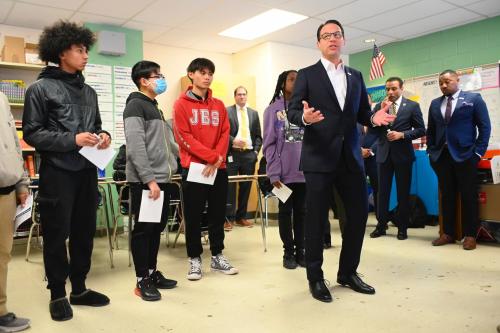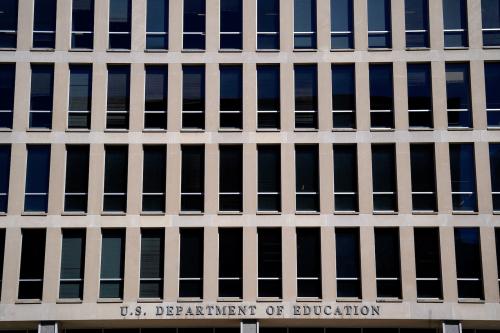This school year, the educational landscape in Houston is undergoing a profound transformation. The state of Texas has taken the reins of school district management and begun implementing an ambitious set of reforms. The Houston takeover has generated significant stakeholder criticism, in part because the district was not the lowest performing in the state, having received a “B” grade on the state’s 2022 A-F Accountability Rating System.
This “state takeover”—a shift from a locally elected school board to state control of the system—not only signifies a pivotal moment for the students and community members in Texas’ largest school district but also the nation. While it is still too early to tell, Houston’s experience could foreshadow a post-pandemic increase in takeovers even beyond the Lone Star State. Houston, which is among the largest districts to have experienced state takeover, draws attention to a strategy for districtwide reform that, while still relatively rare, has been steadily on the rise since the phenomenon began in the late 1980s (see Figure 1).
These state takeovers have happened in all major regions of the country—across states that differ in their political leanings, demographics, and educational contexts (see Figure 2).
There are two main reasons states typically give for enacting takeover: low academic performance and fiscal challenges. In forthcoming work, we show that among the 139 takeovers that have occurred over the past three decades, state leaders have cited fiscal challenges for 68% of takeovers and poor academic performance for 46%. (Note that leaders often cite more than one reason for a takeover.)
The COVID-19 pandemic created academic and fiscal challenges for many districts—especially those already at risk of takeover. It exacerbated preexisting educational inequalities and disproportionately harmed communities most likely to be home to academically low-performing school systems. Meanwhile, pandemic-related federal aid included time-limited fiscal resources that are soon to run out, although many of the problems they were meant to address remain far from solved. This could set the stage for further state interventions. Indeed, the post-pandemic resumption of school accountability has already led states to become more aggressive in their efforts to intervene in low-performing schools.
So, what does the research say about whether state takeovers achieve their primary aims of improving academic achievement and fiscal health? This is a topic that we have examined in recent research.
How does takeover affect academic performance?
To assess takeover impacts on student academic achievement, two of us (Schueler and Bleiberg) studied the 35 takeovers that occurred between 2010-11 and 2015-16. More specifically, we used data on student math and reading performance on state standardized exams that is normed to allow for comparisons across states. We examined whether the change in academic achievement before versus after takeover was greater in takeover districts than the change for districts not targeted for state takeover over the same period. Ultimately, we found no evidence that takeovers, on average, improved student academic performance in math or reading. In fact, we found suggestive evidence that they were disruptive to reading achievement in the early years of reform.
We also observed a considerable amount of variation across districts, with some takeovers resulting in academic improvements and others harming achievement. The most harmful takeovers were undertaken in initially higher-performing districts. The effect of takeover also depended on the racial and ethnic composition of the district. On average, takeovers were more harmful to student achievement when undertaken in majority-Black communities (and more beneficial when enacted in majority-Latino districts). These results suggest that takeovers do not affect all communities in the same ways.
How does takeover affect school district finances?
To assess the effects of takeover on state leaders’ most commonly cited goal—improving fiscal condition—we studied takeovers from 1989-90 to 2018-19. Cited fiscal challenges range from audit violations and non-compliance to failure to maintain a minimum balance in a district’s general reserves. To examine whether takeovers improve fiscal conditions, we compare changes in fiscal health before versus after takeover to the changes in fiscal health over the same period for districts that were not taken over. We examine four measures of fiscal condition: per capita expenditures, cash solvency, budgetary solvency, and long-run solvency. We show that takeovers led to increased state revenues and expenditures per pupil in the targeted districts, primarily by increasing payments on legacy costs (employee benefits and debt retirement). In doing so, takeovers appear to have improved district budgetary and long-run solvency, on average.
However, we find that takeovers did not increase expenditures or other measures of fiscal health in districts serving majority-Black student populations. Again, these findings point to important inequities in takeover impacts.
Why are the impacts of takeover inequitable?
The racially inequitable impacts of takeover—on both academic and fiscal outcomes—are particularly important because takeovers are more likely to occur in communities of color. Notably, this is true even when comparing districts with similar academic performance.
As we illustrate in Figure 3, among the lower-scoring districts in the country, a large share of districts serving very few Black students have avoided takeover while a much smaller share of similarly scoring districts serving large concentrations of Black students have avoided takeover.
Majority-Black communities are therefore most likely to be targeted for takeover and most likely to face risks in terms of the negative impacts of takeover on student achievement and educational spending in these systems.
One possible explanation for this pattern of inequitable results is the influence of state takeover on political representation. Domingo Morel, a political scientist, has studied takeover in relation to local descriptive representation, or the extent to which local elected officials demographically represent the constituents they serve. He finds that when takeover has occurred in majority-Black communities, descriptive representation decreased (i.e., these localities had fewer Black elected officials). However, when enacted in majority-Latino communities, it seems to have paved the way for greater Latino representation in local public office.
As a reminder, in our earlier work, we found that takeovers have generated more positive impacts on student achievement in majority-Latino communities and more negative impacts in majority-Black districts. Others have found that greater non-white representation on school boards positively impacts both spending on and the academic achievement of non-white students. Therefore, takeover may impact student achievement and school funding through its effects on who controls decision-making in targeted communities.
What can be done to improve low-performing school districts?
For states like Texas that have already embarked on takeover, what can be done to maximize the chances that takeover results in academic improvements for children? This is a difficult question to answer because the policies that have generated achievement gains in takeover districts have varied considerably from place to place, as have the characteristics of the local contexts. For example, researchers have documented that takeovers in both New Orleans, Louisiana and Lawrence, Massachusetts successfully improved student achievement, but leaders in these places took very different approaches to turning around academic performance.
Leaders can also look to efforts at improving low-performing school systems that have been undertaken without resorting to district takeover, which tends to generate significant opposition from stakeholders within the targeted communities. A recent meta-analysis of post-No Child Left Behind interventions designed to improve schools/districts labeled as low performing shows that extended learning time and efforts to improve the quality of the teaching force are associated with greater gains in both math and reading achievement. Individualized instructional approaches, especially when implemented with teachers selected based on merit, are also a promising approach.
In sum, research suggests that takeovers are not a silver bullet for improving struggling school systems. They have been better suited to addressing financial than academic concerns, and they appear to be especially risky when undertaken in majority-Black communities and within school districts that are not among the lowest performing in the country. That said, research on the subset of takeovers that have generated benefits—as well as on efforts to improve low-performing districts without a dramatic governance change—provide some guidance for how leaders in Texas and beyond might reasonably approach school district reform.
The Brookings Institution is committed to quality, independence, and impact.
We are supported by a diverse array of funders. In line with our values and policies, each Brookings publication represents the sole views of its author(s).










